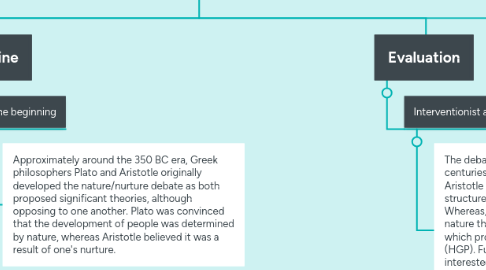
1. The Debate
1.1. It is safe to make the assumption that one's characteristics may be primarily influenced by genetic inheritance including hair or eye colour or other similar aspects. But the question still remains -to what extent does nature and nurture interact during a child's development and traits.
1.2. Language Acquisition: Language acquisition is the development of speech and understanding of grammar, but some linguists may include the physical maturation of the organs responsible for phonation (ie larynx, tongue etc.)
1.3. Nature
1.3.1. Nature is the inherited characteristics, the influence of biology. Both the biological -especially- and psychoanalytical are largely hereditarians.
1.4. Nurture
1.4.1. Considers social and environmental influences and how it effects a person's physical and psychological progressions. Whereas the two approaches which are predominantly nurture-based are Humanism and Behaviorism
1.5. Feral Children
1.5.1. Feral children date back to the very beginning, as lore said the founders of Rome (Romulus and Remus), were raised by a shewolf. Feral children are the natural experiment, along with twin studies, as it would be unethical to conduct otherwise, therefore may give a more definite answer regarding the debate. An example of this is this is a profound story -in the 1970s- of Genie Wiley, at the age 13 she was discovered deprived of nutrients, sleep, nurturing parental socialisation, overall contact with people and constrained in a makeshift straightjacket for the majority of her life. Her ability to vocalise was horribly restricted due to her severe mistreatment. Linguist became specifically interested, as they hypothesised it could help the discussion of language development and acquisition. Along with other feral child(ren) cases, a generalised conclusion of [depending on the time of the discovery of the child how substantial their grammatical and vocabulary growth will be]. But sadly as our knowledge of the brain surrounding this area is limited so helping feral children overcome this difficulty is limited. Although our knowledge of feral children in relation to language acquisition is limited it still helps our understanding as more children are being discovered; technology progresses.
2. Time line
2.1. In the beginning
2.1.1. Approximately around the 350 BC era, Greek philosophers Plato and Aristotle originally developed the nature/nurture debate as both proposed significant theories, although opposing to one another. Plato was convinced that the development of people was determined by nature, whereas Aristotle believed it was a result of one's nurture.
2.2. 1600s
2.2.1. John Locke, an English philosopher, who advocated all people are born with a 'tabula rasa' -the English translation being 'blank slate'- all knowledge is acquired via experience (closely intertwining to the behavioural approach) whilst dismissing the general concept of the hereditarians, he believed that some concepts were innate. For example like distinguishing right from wrong.
2.3. 1800s
2.3.1. During the early 1800s Charles Darwin published a book entitled 'On the Origin of Species', which supported nature. Herbert Spencer then condensed Darwin's work into a revolutionary term 'Survival of the Fittest'
2.3.1.1. 1859
2.3.1.1.1. Francis Galton (a relative to Charles Darwin) founded the term eugenics, essentially being the science of perfecting desired traits or eminence and adjusting the gene pool to do so. But after Galton's death, an idea which he did not explicitly intend was "negative eugenics" where 'pruning' of undesirable or degenerate traits and people lost the right of reproduction. An example of this is during the establishment of Nazi Germany, as Adolf Hitler believed he could breed the Aryan race, exterminating anyone manifesting dissatisfaction.
2.4. 1950- 1960s
2.4.1. 1957
2.4.1.1. B.F Skinner, a behaviourist, therefore his explanation for child development and language acquisition was a result of the sufficient or insufficient exposure to verbal communication, but also considered the importance of the non-verbal communication (i.e facial expressions).
2.4.2. 1965
2.4.2.1. Whereas Noam Chomsky (an extreme nativist) opposed Skinner’s idea, and that a child required more than reinforcement and priples of association. Composed into the term 'innate learning'.
2.5. 1990s
2.5.1. Prior to the establishment of the Human Genome Project it took two years of intense planning and would take an estimated 15 years to map out all genes possible. Researches thought this was important to investigate to treat and decrease the severity (through tracking) of inherited diseases.
2.6. 2000s
2.6.1. 2003
2.6.1.1. The intent of the Human Genome Project was completed accurately and comprehensively. With an outstanding result stated by the National Human Genome Research Institute that there are a suggested 20,500 genes within the human genome. With this information gave an approximate value to what percentage language acquisition is influenced innately (nature) or environmentally (nurture).
2.6.2. 2007
2.6.2.1. Epigenetics, the study of the expressions of genes alter via environmental and personal experiences, rather than the purposeful physical mutation of a genome; whether this can be passed down into further generations or not . This idea was revolutionary to the discussion.
2.6.2.1.1. Children are more susceptible to epigenetic changes as sensory dimensions are being explored, and connections within the brain are being formed and some are being strengthened. Hence, children are likely to experience genomic alteration.
3. Evaluation
3.1. Interventionist and the overall debate
3.1.1. The debate has changed dramatically over centuries. People such as Plato (nativist) and Aristotle (empiricist) who ignited the basic structure of what forms one's personality. Whereas, throughout the 20th century the nature theory became noticeably reinforced, which prompted the erosion of neurosciences (HGP). Furthermore, becoming increasingly interested with the interaction of the two factors, with twin studies (which I believe is relevant for personality development; mental health, rather than language acquisition).
